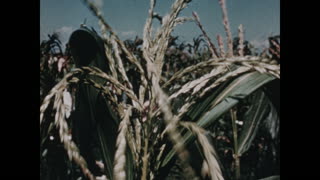Photographed and directed by A.C. Twomey for Gulf Oil Corporation, “Harvest of Science” (late 1940s) looks at the modern approach to farming, emphasizing a blend of traditional values and scientific advancements, including the use of petroleum based pesticides in agriculture. The importance of soil treatment and crop rotation is explained, as well as the role of nitrogen in agriculture and the benefits of soil testing. It introduces flame cultivation for cotton and shows the shift towards mechanization in farming. Advancements in corn breeding, including hybrid corn and increasing oil content, are discussed, along with the development of non-pollen shedding corn plants to reduce detasseling. The evolution of corn harvesting technology, including the picker-sheller machine, is described. The film also covers the use of farm waste products in livestock feed and the scientific study of cattle digestion. The benefits of scientific research in improving feed efficiency and solving problems like bloat are highlighted. Artificial insemination in dairy farming and its impact on herd improvement are discussed, along with the pipeline milking system and its benefits for large dairy operations. The role of diagnostic laboratories in detecting livestock diseases and ensuring animal health is covered, followed by a discussion on the impact of insects on crops and the development of insecticides. The war against insect pests and the testing of new insecticides are described, highlighting the use of microorganisms in producing vitamins, chemicals, and antibiotics. The development of dextran from sugar processing waste and its use as a blood plasma substitute is discussed. The text concludes with the modern approach to farming, emphasizing the blend of traditional values and scientific advancements.
00:00: Introduction with music.
0:47: Describes the transition from summer to autumn, highlighting the changing colors and the end of summer’s dance.
1:31: Discusses the significance of autumn for farmers, focusing on the harvest and the role of science in modern agriculture.
Ford tractor and harvester. 2
:22: Explains the importance of soil treatment and crop rotation, using examples from University of Illinois’ Dr. M.B. Russell’s research on corn yields.
The Morrow Plots are shown. 3:15: Highlights the role of nitrogen in agriculture and the benefits of soil testing.
4:02: Emphasizes the consistent high yields from properly treated soils.
4:16: Introduces flame cultivation for cotton and the shift towards mechanization in farming.
4:43: Describes the mechanization of cotton harvesting and its impact on Southern agriculture.
5:05: Focuses on the advancements in corn breeding, including hybrid corn and increasing oil content.
7:12: Discusses the development of non-pollen shedding corn plants to reduce the need for detasseling.
7:16: Storing ear corn in a barn. Describes the evolution of corn harvesting technology, including Minneapolis Moline picker-sheller machine.
8:48: Cows / cattle on the farm. Talks about the use of farm waste products in livestock feed and the scientific study of cattle digestion.
9:51: Cow with a window in its stomach — a lucite plug that allows scientists to see into the stomach 11:02: Functioning of a cow’s stomach and the role of bacteria in breaking down cellulose.
11:04: Scientist in a lab, research in improving feed efficiency and solving problems like bloat.
12:03: Discusses artificial insemination in dairy farming and its impact on herd improvement.
13:29: Illinois Breeding Co-Op. Describes the pipeline milking system and its benefits for large dairy operations.
15:00: Covers the role of diagnostic laboratories in detecting livestock diseases and ensuring animal health.
16:36: Caterpillars, grasshoppers. Talks about the impact of insects on crops and the development of insecticides.
18:05 : Describes the war against insect pests and the testing of new insecticides.
19:21: Highlights the use of microorganisms in producing vitamins, chemicals, and antibiotics. 19:46: Gulf chemical plant.
21:12: Discusses the development of dextran from sugar processing waste and its use as a blood plasma substitute.
23:54: Girl watches a bulldozer excavate. Young people at a county fair with prize animals, probably 4H Club members. Dancing and amusement rides shown, as well as cotton candy. Horse racing. Conclusion with the modern approach to farming, emphasizing the blend of traditional values and scientific advancements.
This film is part of the Periscope Film LLC archive, one of the largest historic military, transportation, and aviation stock footage collections in the USA. Entirely film backed, this material is available for licensing in 24p HD, 2k and 4k. For more information visit http://www.PeriscopeFilm.com


